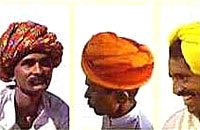People Rajasthan
| Rajasthani People |
|
In olden days, the profession of the people decided their caste. This system has now been broken. Today, individuals have the freedom to opt for any profession irrespective of caste. The profession based caste system has now been transformed into birth-based caste system. People of various castes and sub-castes reside in Rajasthan.
The Rajasthanis are sturdy, cheerful and simple folks relatively untouched by the fast pace of modern times making Rajasthan one of the safest destinations anywhere in the world.
|
|
|
|
Colourful and Ornamental |
It is also one of the most colourful. To offset the barren, colourless landscape and the monotony of its cloudless sky, the people of Rajasthan show a distinct preference for bright costumes. From the simple village folk or tribal to the rajas and ranis, the preferred colours are bright red, dazzling yellow, lively green or brilliant orange, highlighted by a lavish use of sparkling gold and silver zari or
gota. costumes. From the simple village folk or tribal to the rajas and ranis, the preferred colours are bright red, dazzling yellow, lively green or brilliant orange, highlighted by a lavish use of sparkling gold and silver zari or
gota.
Tribal and nomadic women are known for their love for silver jewellery (although men too sport ear studs and earrings). The ornaments follow age-old designs typical of a particular tribe. In daily use the ladies wear normal ornaments of neck, hand, nose and ear but on special occasions and social functions. Women wear all the ornaments of different parts of the body to look beautiful and attractive. For its exquisite designs and delicacy of art Rajasthan Jewelry is a rage not only for ladies of India but also for women of foreign countries. |
|
|
|
Mind-boggling Turbans |
In India, the turban is popularly known as a pagdi. There are different variations of the turban, depending on the religion and region. In fact, in Rajasthan, it is said that the turban style changes with every 15km you travel. And Rajput turbans are different from Sikh turbans, which are in turn different from the classical Arab turbans. Then, there are the royal turbans from different parts of India, and the rural turban which is often just a towel wound round the head. India is a land of diversities. And it is all the more pronounced in Rajasthan. An old local saying sums it up -
style changes with every 15km you travel. And Rajput turbans are different from Sikh turbans, which are in turn different from the classical Arab turbans. Then, there are the royal turbans from different parts of India, and the rural turban which is often just a towel wound round the head. India is a land of diversities. And it is all the more pronounced in Rajasthan. An old local saying sums it up -
"The dialect, cuisine, water and turbans in Rajasthan change every 12 miles."
In fact there are about 1,000 different styles and types of turbans in Rajasthan, each denoting the class, caste and region of the wearer.Turbans come in all shapes, sizes and colours; and there are specific turbans for specific occasions as well. |
|
|
|
A lineage of beautiful women |
|
Rajasthani women have been renowned for their grace and beauty. Alauddin Khilji, the Sultan of Delhi, was so smitten by the beauty of the legendary Maharani Padmini Devi of Chittaurgarh that he waged a war -in vain - for her hand. In her heydays, the present day Rajmata of Jaipur, Maharani Gayatri Devi, was considered by Vogue to be amongst the Ten Most Beautiful Women in the World. And her charm hasn't diminished one bit till today! |
|
|
|
Marwaris - the Jews of India |
|
The term Marwari literally refers to someone who hails from or is an inhabitant of Marwar - the erstwhile Jodhpur state. This term gained currency initially in Bengal, where the traders from Shekhawati and other parts of Rajasthan established their business empires. Distinct in their dress, customs and language, the traders and merchants of Rajasthan came to be known as Marwaris. Rajasthan's greatest contribution to the country's economy has been in the field of Human Resources. The term Marwari is a misnomer. Literally speaking, it signifies a person from the Marwar(Jodhpur) region of Rajasthan, although the majority of Rajasthan's businessmen are from the Shekhavati belt. However, colloquially it has come to denote emigrant businessmen from the vicinity of
Rajasthan.
Traditionally, traders par excellence, they migrated from their home state way back in the 16th century and established trading outposts as far away as Assam - the eastern corner of India. With their ingrained thrift and perseverance (in those days, people had to walk miles and miles over scorching sands for a pot of water!) and business acumen, they soon converted these small businesses into industrial empires. Today, the marwaris dominate India's business and economy. As an American sociologist put it,
"more than half the assets in the modern sector of the Indian economy are controlled by the trading castes originating in the northern half of
Rajasthan."
|
|
|
|
|
|
|
| Incredible india |
| » | |
| » | |
| » | |
| » | |
| » | |
| » | |
| » | |
|
| |
| India package tours |
| » | |
| » | |
| » | |
| » | |
| » | |
| » | |
| » | |
| » | |
| » | |
| » | |
|
| |
|
|